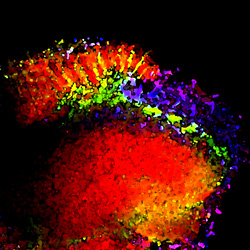Areas of Interest
Research Interests
Signal Transduction in the Nervous System
Every organism needs to adapt to changes in its environment to ensure optimal growth and survival. In eukaryotes, the nervous system is responsible for gathering and processing information concerning changes in both the internal and external environments. In our laboratory we take a multi-tiered approach to study how the nervous system develops, and allows animals to make optimal decisions in a complex and ever-changing environment.
Identification of Novel Components of the “Synaptic Developtome”
The number of synaptic connections neurons make with other cells is a key determinant in the efficacy of information transfer in the nervous system. The various proteins involved in the regulation of synaptic growth and connectivity during development of the nervous system constitute the “synaptic developtome”. In our lab we use a series of genetic, cell-biological, and electrophysiological approaches to identify novel components of the synaptic developtome in Drosophila. Ultimately, we hope that modifying the expression and activity of these molecules will have profound effects in regulation of synaptic development, and may have therapeutic implications in several neurological and psychiatric diseases.
Molecular Mechanisms of Vesicular Trafficking and Function
Vesicles like endosomes and lysosomes play key roles in many biological pathways. In our lab we are taking a reverse-genetic approach to identify new molecules involved in the trafficking and function of these organelles. Our studies are relevant to a variety of human diseases such as cancer, neurodegenerative disease, and lysosomal storage disorders.
Neuronal Networks of Decision-Making in Adult Drosophila
Circuits in the nervous system rapidly make decisions that are best suited for the survival of the organism. This high-level decision making reflects constant competition between neuronal circuits in the brain. We are using adult Drosophila to investigate the mechanisms of decision making processes at molecular and network levels by studying interactions between different sensory modalities.

Publications
REFERENCES
- Wong CO, Palmieri M, Li J, Akhmedov D, Chao Y, Broadhead GT, Zhu MX, Berdeaux R, Collins CA, Sardiello M, and Venkatachalam K. (2015). Diminished MTORC1-Dependent JNK-Activation Underlies the Neurodevelopmental Defects Associated with Lysosomal Dysfunction. Cell Rep., Sep 29;12(12):2009-20. doi: 10.1016/j.celrep.2015.08.047. Epub Sep 17.
- Zhou Y, Wong CO, Cho KJ, van der Hoeven D, Liang H, Thakur DP, Luo J, Babic M, Zinsmaier KE, Zhu MX, Hu H, Venkatachalam K and Hancock JF. (2015). Membrane potential modulates plasma membrane phospholipid dynamics and K-Ras signaling. Science, Aug 21;349(6250):873-6. doi: 10.1126/science.aaa5619.
- Venkatachalam K, Luo J, Montell C. (2014). Evolutionarily Conserved, Multitasking TRP Channels—Lessons From Worms and Flies. Handbook of Experimental Pharmacology, Edition on “Mammalian Transient Receptor Potential (TRP) Channels”. 223, 937-962.
- Venkatachalam K, Wong CO, Zhu MX. (2014).The Role of TRPMLs in Endolysosomal Trafficking and Function. Cell Calcium, Oct 28. pii: S0143-4160(14)00163-8. In press.
- Wang S, Tan KL, Agosto MA, Xiong B, Yamamoto S, Sandoval H, Jaiswal M, Bayat V, Zhang K, Charng W-L, David G, Duraine L, Venkatachalam K, Wensel TG, Bellen HJ. (2014). The Retromer Complex is Required for Rhodopsin Recycling and Its Loss Leads to Photoreceptor Degeneration. PLoS Biology, 12(4):e1001847.
- Wong CO, Chen K, Lin YQ, Chao Y, Duraine L, Lu Z, Yoon WH, Sullivan JM, Broadhead GT, Sumner CJ, Lloyd TE, Macleod GT, Bellen HJ, Venkatachalam K. (2014). A TRPV Channel in Drosophila Motor Neurons Regulates Presynaptic Resting Ca2+ Levels, Synapse Growth, and Synaptic Transmission. Neuron., 84, 764-777 (Cover Article).
- Feng X, Huang Y, Lu Y, Xiong J, Wong CO, Yang P, Xia J, Chen D, Du G, Venkatachalam K, Xia X, Zhu MX. (2013). Drosophila TRPML forms PI(3,5)P2-activated cation channels in both endolysosomes and plasma membrane. J Biol Chem., [Epub ahead of print].
- Venkatachalam K*, Wong CO, and Montell C*. (2013). Feast or Famine: Role of TRPML in Preventing Cellular Amino Acid Starvation. Autophagy 9, 98-100 (Cover Article) (*, corresponding authors).
- Wong CO, Li R, Montell C, and Venkatachalam K. (2012). Drosophila TRPML is Required for TORC1 Activation. Curr Biol 22, 1616-1621.
- Venkatachalam K, Wasserman D, Wang X, Li R, Mills E, Elsaesser R, Li H-S, and Montell C. (2010). Dependence on a Retinophilin/Myosin Complex for Stability of PKC and INAD and Termination of Phototransduction J Neurosci, 30, 11337-11345.
- Venkatachalam K, Long A, Elsaesser R, Nikolaeva D, Broadie K, and Montell C. (2008). Motor deficit in a Drosophila model of mucolipidosis type IV due to defective clearance of apoptotic cells. Cell, 135, 838-851.
- Venkatachalam K, and Montell C. (2007). TRP Channels Ann Rev Biochem 76, 387-417.
- Kalra D, Elsaesser R, Gu Y, and Venkatachalam K*. (2007). Transducin in Rod Photoreceptors – Translocated When Not Terminated. J Neurosci, 27, 6349-6351 (*- Corresponding author).
- Soboloff J, Spassova M, Hewavitharana T, He L-P, Luncsford P, Xu W, Venkatachalam K, van Rossum D, Patterson RL, and Gill DL. (2007). TRPC Channels: Integrators of Multiple Cellular Signals. Handb Exp Pharmacol, 179, 575-591.
- Venkatachalam K, Hofmann T, and Montell C. (2006). Lysosomal Localization of TRPML3 Regulated by Interactions with TRPML2 and Mucolipidosis-associated Protein TRPML1 J Biol Chem, 281, 17517-17527.
- Spassova MA, Soboloff J, He L-P, Hewavitharana T, Xu W, Venkatachalam K, van Rossum DB, Patterson RL, and Gill DL. (2004). Calcium Entry Mediated by SOCs and TRP Channels: Variations and Enigma. Biochim Biophys Acta, 1742, 9-20.
- Venkatachalam K, Zheng F, and Gill DL. (2004). Control of TRPC and Store-Operated Channels by Protein Kinase C. Novartis Found Symp, 258, 172-185; Discussion 185-188, 263-266.
- Ma H-T, Venkatachalam K*, Rys-Sikora K E, He L-P, Zheng F, and Gill DL. (2003). Modification of Phospholipase C-ϒ-Induced Ca2+ Signal-generation by 2-Aminoethoxy diphenyl Borate. Biochem J, 376, 667-676 (*- Joint First Author).
- Venkatachalam K, Zheng F, and Gill DL. (2003). Regulation of TRPC Channel Function by Diacylglycerol and Protein Kinase C. J Biol Chem, 278, 29031-29040.
- Venkatachalam K, van Rossum DB, Patterson RL, Ma H-T, and Gill DL. (2002). The Cellular and Molecular Basis of Store-Operated Calcium Entry. Nat Cell Biol, 4, E263-E272.
- Ma H-T, Venkatachalam K, Parys JB, and Gill DL. (2002). Modification of Store-operated Channel-coupling and InsP3 Receptor-function by 2-Aminoethoxydiphenylborate in DT40 Lymphocytes. J Biol Chem, 277, 6915-6922.
- Venkatachalam K, Ma H-T, Ford DL, and Gill DL. (2001). Expression of Functional Receptor-Coupled TRPC3 Channels in DT40 Triple InsP3 Receptor-Knockout Cells. J Biol Chem, 276, 33980-33985 (Featured in Faculty of 1000).
- Ma H-T, Venkatachalam K*, Li H-S, Montell C, Kurosaki T, Patterson RL, and Gill DL. (2001). Assessment of the Role of the Inositol 1,4,5-Trisphosphate Receptor in the Activation of Transient Receptor Potential Channels and Store-Operated Ca2+ Entry Channels. J Biol Chem, 276, 18888-18896 (*- Joint First Author).
